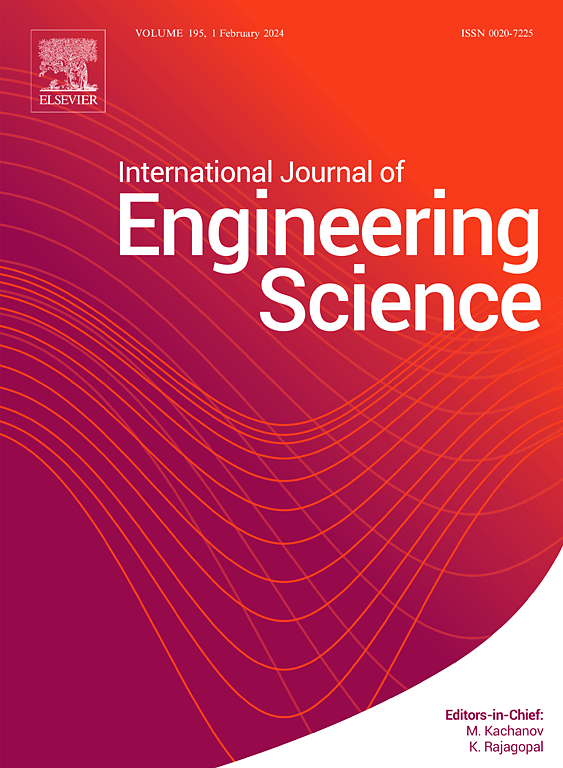Design of resilient structures by randomization and bistability
IF 5.7
1区 工程技术
Q1 ENGINEERING, MULTIDISCIPLINARY
International Journal of Engineering Science
Pub Date : 2025-05-23
DOI:10.1016/j.ijengsci.2025.104296
引用次数: 0
Abstract
This paper examines various ways of improving the impact resilience of protective structures. Such structures’ purpose is to dissipate an impact’s energy while avoiding cracking and failure. We have tested the reaction of plane elastic-brittle lattices to an impulse. Four topologies are compared: periodic triangular, square, and hexagonal topologies, and aperiodic Penrose topology. Then, structures with random variations of the links’ stiffness, node positions, and random holes are compared. Combinations of these random factors are also considered, as well as the resilience of bistable elastic-brittle lattices with sacrificial links. Several parameters are introduced to measure the structural resilience of the compared designs: (i) the amount of dissipated impact energy, (ii) the size of broken clusters of links, and (iii) the spread of damage. The results suggest new routes for rationally designing protective structures using nonperiodic topology, bistability, and structural randomness. In particular, we find that some quantities of interest can be maximized by tuning the randomized design appropriately — for example, randomly removing 8% of links maximizes energy dissipation. We also find that randomization of bistable lattices can offer superior energy dissipation while reducing the connectivity between broken clusters of links.
基于随机和双稳性的弹性结构设计
本文探讨了提高防护结构冲击弹性的各种方法。这种结构的目的是分散冲击的能量,同时避免开裂和破坏。我们测试了平面弹脆晶格对脉冲的反应。比较了周期三角形、方形、六边形拓扑和非周期Penrose拓扑。然后,比较了随机变化连杆刚度、节点位置和随机孔洞的结构。本文还考虑了这些随机因素的组合,以及具有牺牲链接的双稳弹脆晶格的弹性。引入了几个参数来衡量比较设计的结构弹性:(i)耗散的冲击能量,(ii)断裂链接簇的大小,以及(iii)损伤的扩散。研究结果为利用非周期拓扑、双稳定性和结构随机性合理设计防护结构提供了新的思路。特别是,我们发现一些感兴趣的量可以通过适当地调整随机设计来最大化——例如,随机删除8%的链接使能量消耗最大化。我们还发现,双稳格的随机化可以提供更好的能量耗散,同时减少断裂链路簇之间的连通性。
本文章由计算机程序翻译,如有差异,请以英文原文为准。
求助全文
约1分钟内获得全文
求助全文
来源期刊

International Journal of Engineering Science
工程技术-工程:综合
CiteScore
11.80
自引率
16.70%
发文量
86
审稿时长
45 days
期刊介绍:
The International Journal of Engineering Science is not limited to a specific aspect of science and engineering but is instead devoted to a wide range of subfields in the engineering sciences. While it encourages a broad spectrum of contribution in the engineering sciences, its core interest lies in issues concerning material modeling and response. Articles of interdisciplinary nature are particularly welcome.
The primary goal of the new editors is to maintain high quality of publications. There will be a commitment to expediting the time taken for the publication of the papers. The articles that are sent for reviews will have names of the authors deleted with a view towards enhancing the objectivity and fairness of the review process.
Articles that are devoted to the purely mathematical aspects without a discussion of the physical implications of the results or the consideration of specific examples are discouraged. Articles concerning material science should not be limited merely to a description and recording of observations but should contain theoretical or quantitative discussion of the results.
 求助内容:
求助内容: 应助结果提醒方式:
应助结果提醒方式:


